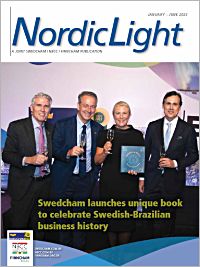On March 29th, Swedcham’s Legal and Business Committee held its first 2023 event on the Transfer Prices and OECD Convergence. The speaker was Dr. Roberto Codorniz Leite Pereira. He is a Professor of the Professional Master’s Program in International Taxation and Development of the Brazilian Institute of Tax Law (IBDT). He is a Ph.D. in Economic, Financial and Tax from the University of São Paulo Law School FDUSP and also a Master of Laws (LL.M.) in International Tax Law) from the Vienna University (WU) as well as Partner of Maneira Advogados.
According to Roberto, transfer price regulations in Brazil have historically reflected traditional parameters that deviated from the arm’s length standard. This fixed model focused on the application of fixed margins to ensure practicability and legal certainty. However, given that digital economy has a strong reliance on intangibles and the loopholes exploited by taxpayers, the OECD recommended that Brazilian Transfer Pricing rules were revisited.
In this context, after years of joint work with the OECD tax officials, it was published the Provisional Measure n. 1.152/2022, recently converted into Federal Law n. 14.596/23 whose main purpose was to provide for a full convergence of Brazilian Transfer Pricing Rules with the transfer pricing guidelines from the OECD.
In a nutshell, the new transfer pricing regulation includes: (1) a statement providing that the arm’s length is the guiding principle in transfer pricing analysis; (2) a broader concept for related parties – covering situations where one party is under the ‘directly or indirectly exerted influence’; (3) the delineation of transactions aimed to identify the economic and financial relations among the tested parties as well as the economically relevant characteristics of the controlled transaction; (4) specific provisions for commodities; (5) specific provisions for intragroup cost sharing and service agreements; (6) the application of transfer pricing rules on business restructuring; (7) the application of transfer pricing rules to financial transactions in general; (8) the application to intangibles in general.
Furthermore, the new regulation provides for the ‘best method approach’ to determine the arm’s length methods, taking into consideration the delineated controlled transaction and the comparability analysis with transactions contracted with unrelated parties. According to the previous regulation on transfer pricing, where the ‘best method rule’ was not applicable, taxpayers were entitled to choose among the traditional methods with predetermined margins the one with the best outcome (i.e., the least burdensome). This is also a remarkable change in Brazilian transfer pricing legislation.
Professor Roberto Codorniz also had the opportunity to answer questions from the Swedish company members attending the event and contributed to enhance Swedcham membership exchange of best practices and knowledge sharing.
Thank you, Roberto!
Renato Pacheco e Silva Bacellar Neto is partner at Pacheco Neto Sanden Teisseire Law Firm.




